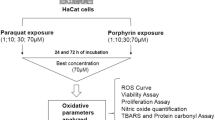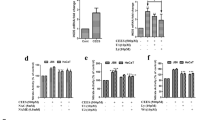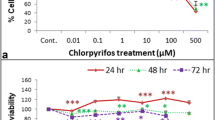Abstract
Polychlorinated biphenyls (PCBs) and their metabolites are environmental pollutants that are known to have adverse health effects. 1-(4-Chlorophenyl)-benzo-2,5-quinone (4-ClBQ), a quinone metabolite of 4-monochlorobiphenyl (PCB3, present in the environment and human blood) is toxic to human skin keratinocytes, and breast and prostate epithelial cells. This study investigates the hypothesis that 4-ClBQ-induced metabolic oxidative stress regulates toxicity in human keratinocytes. Results from Seahorse XF96 Analyzer showed that the 4-ClBQ treatment increased extracellular acidification rate, proton production rate, oxygen consumption rate and ATP content, indicative of metabolic oxidative stress. Results from a q-RT-PCR assay showed significant increases in the mRNA levels of hexokinase 2 (hk2), pyruvate kinase M2 (pkm2) and glucose-6-phosphate dehydrogenase (g6pd), and decreases in the mRNA levels of succinate dehydrogenase (complex II) subunit C and D (sdhc and sdhd). Pharmacological inhibition of G6PD-activity enhanced the toxicity of 4-ClBQ, suggesting that the protective function of the pentose phosphate pathway is functional in 4-ClBQ-treated cells. The decrease in sdhc and sdhd expression was associated with a significant decrease in complex II activity and increase in mitochondrial levels of ROS. Overexpression of sdhc and sdhd suppressed 4-ClBQ-induced inhibition of complex II activity, increase in mitochondrial levels of ROS, and toxicity. These results suggest that the 4-ClBQ treatment induces metabolic oxidative stress in HaCaT cells, and while the protective function of the pentose phosphate pathway is active, inhibition of complex II activity sensitizes HaCaT cells to 4-ClBQ-induced toxicity.







Similar content being viewed by others
Abbreviations
- 4-ClBQ:
-
1-(4-Chlorophenyl)-benzo-2,5-quinone
- 2-NBDG:
-
2-(N-(7-nitrobenz-2-oxa-1,3-diazol-4-yl)amino)-2-deoxyglucose
- BSO:
-
l-Buthionine sulfoximine
- DHEA:
-
Dehydroepiandrosterone
- ECAR:
-
Extracellular acidification rate
- mBBr:
-
Monobromobimane
- METC:
-
Mitochondrial electron transport chain
- MFI:
-
Mean fluorescence intensity
- NBT:
-
Nitro-blue tetrazolium chloride
- OCR:
-
Oxygen consumption rate
- OXPHOS:
-
Oxidative phosphorylation
- PCBs:
-
Polychlorinated biphenyls
- PCB3:
-
4-Monochlorobiphenyl
- PEG-SOD:
-
Polyethylene glycol-superoxide dismutase
- PPP:
-
Pentose phosphate pathway
- PPR:
-
Proton production rate
- ROS:
-
Reactive oxygen species
- SDH:
-
Succinate dehydrogenase
References
Aly HA, Domenech O (2009) Aroclor 1254 induced cytotoxicity and mitochondrial dysfunction in isolated rat hepatocytes. Toxicology 262:175–183. doi:10.1016/j.tox.2009.05.018
Balaban RS, Nemoto S, Finkel T (2005) Mitochondria, oxidants, and aging. Cell 120:483–495. doi:10.1016/j.cell.2005.02.001
Boukamp P, Petrussevska RT, Breitkreutz D, Hornung J, Markham A, Fusenig NE (1988) Normal keratinization in a spontaneously immortalized aneuploid human keratinocyte cell line. J Cell Biol 106:761–771
Boveris A (1977) Mitochondrial production of superoxide radical and hydrogen peroxide. Adv Exp Med Biol 78:67–82
Cosentino C, Grieco D, Costanzo V (2011) ATM activates the pentose phosphate pathway promoting anti-oxidant defence and DNA repair. EMBO J 30:546–555. doi:10.1038/emboj.2010.330
Cossarizza A et al (2009) Simultaneous analysis of reactive oxygen species and reduced glutathione content in living cells by polychromatic flow cytometry. Nat Protoc 4:1790–1797. doi:10.1038/nprot.189
DeCaprio AP et al (2005) Polychlorinated biphenyl (PCB) exposure assessment by multivariate statistical analysis of serum congener profiles in an adult Native American population. Environ Res 98:284–302. doi:10.1016/j.envres.2004.09.004
Filosa S et al (2003) Failure to increase glucose consumption through the pentose-phosphate pathway results in the death of glucose-6-phosphate dehydrogenase gene-deleted mouse embryonic stem cells subjected to oxidative stress. Biochem J 370:935–943. doi:10.1042/bj20021614
Hansen LG, DeCaprio AP, Nisbet ICT (2003) PCB congener comparisons reveal exposure histories for residents of Anniston, Alabama, USA. Fresenius Environ Bull 12:181–190
Herrick RF, Lefkowitz DJ, Weymouth GA (2007) Soil contamination from PCB-containing buildings. Environ Health Perspect 115:173–175. doi:10.1289/ehp.9646
Herrick RF, Meeker JD, Altshul L (2011) Serum PCB levels and congener profiles among teachers in PCB-containing schools: a pilot study. Environ Health 10:56–66. doi:10.1186/1476-069x-10-56
Hu D, Hornbuckle KC (2009) Inadvertent polychlorinated biphenyls in commercial paint pigments. Environ Sci Technol 44:2822–2827. doi:10.1021/es902413k
Hu D, Lehmler HJ, Martinez A, Wang K (2010) Hornbuckle KC (2010) Atmospheric PCB congeners across Chicago. Atmos Environ 44:1550–1557. doi:10.1016/j.atmosenv.01.006
Lauby-Secretan B et al (2013) Carcinogenicity of polychlorinated biphenyls and poly-brominated biphenyls. Lancet Oncol 14:287–288. doi:10.1016/s1470-2045(13)70104-9
Lehmler HJ, Robertson LW (2001) Synthesis of polychlorinated biphenyls (PCBs) using the Suzuki-coupling. Chemosphere 45:137–143
Liebl B, Schettgen T, Kerscher G, Broding HC, Otto A, Angerer J, Drexler H (2004) Evidence for increased internal exposure to lower chlorinated polychlorinated biphenyls (PCB) in pupils attending a contaminated school. Int J Hyg Environ Health 207:315–324. doi:10.1078/1438-4639-00296
Lunt SY, Vander Heiden MG (2011) Aerobic glycolysis: meeting the metabolic requirements of cell proliferation. Annu Rev Cell Dev Biol 27:441–464. doi:10.1146/annurev-cellbio-092910-154237
Martinez A, Erdman NR, Rodenburg ZL, Eastling PM, Hornbuckle KC (2012) Spatial distribution of chlordanes and PCB congeners in soil in Cedar Rapids, Iowa, USA. Environ Pollut 161:222–228. doi:10.1016/j.envpol.2011.10.028
McLean MR, Bauer U, Amaro AR, Robertson LW (1996) Identification of catechol and hydroquinone metabolites of 4-monochloro-biphenyl. Chem Res Toxicol 9:158–164. doi:10.1021/tx950083a
Nishihara Y, Robertson LW, Oesch F, Utsumi K (1986) The effects of tetrachlorobiphenyls on the electron transfer reaction of isolated rat liver mitochondria. Life Sci 38:627–635
Pandolfi PP, Sonati F, Rivi R, Mason P, Grosveld F, Luzzatto L (1995) Targeted disruption of the housekeeping gene encoding glucose 6-phosphate dehydrogenase (G6PD): G6PD is dispensable for pentose synthesis but essential for defense against oxidative stress. EMBO J 14:5209–5215
Pardini RS (1971) Polychlorinated biphenyls (PCB): effect on mitochondrial enzyme systems. Bull Environ Contam Toxicol 6:539–545
Ross G (2004) The public health implications of polychlorinated biphenyls (PCBs) in the environment. Ecotoxicol Environ Saf 59:275–291. doi:10.1016/j.ecoenv.2004.06.003
Safe S (1993) Toxicology, structure-function relationship, and human and environmental health impacts of polychlorinated biphenyls: progress and problems. Environ Health Perspect 100:259–268
Salvemini F, Franze A, Iervolino A, Filosa S, Salzano S, Ursini MV (1999) Enhanced glutathione levels and oxidoresistance mediated by increased glucose-6-phosphate dehydrogenase expression. J Biol Chem 274:2750–2757
Silverstone AE, Rosenbaum PF, Weinstock RS, Bartell SM, Foushee HR, Shelton C, Pavuk M (2012) Polychlorinated biphenyl (PCB) exposure and diabetes: results from the Anniston Community Health Survey. Environ Health Perspect 120:727–732. doi:10.1289/ehp.1104247
Slane BG, Aykin-Burns N, Smith BJ, Kalen AL, Goswami PC, Domann FE, Spitz DR (2006) Mutation of succinate dehydrogenase subunit C results in increased O ·−2 , oxidative stress, and genomic instability. Cancer Res 66:7615–7620. doi:10.1158/0008-5472.CAN-06-0833
Song Y, Wagner BA, Witmer JR, Lehmler HJ, Buettner GR (2009) Nonenzymatic displacement of chlorine and formation of free radicals upon the reaction of glutathione with PCB quinones. Proc Natl Acad Sci USA 106:9725–9730. doi:10.1073/pnas.0810352106
Song Y, Wagner BA, Lehmler HJ, Buettner GR (2008) Semiquinone radicals from oxygenated polychlorinated biphenyls: electron paramagnetic resonance studies. Chem Res Toxicol 21:1359–1367. doi:10.1021/tx8000175
Spitz DR, Azzam EI, Li JJ, Gius D (2004) Metabolic oxidation/reduction reactions and cellular responses to ionizing radiation: a unifying concept in stress response biology. Cancer Metastasis Rev 23:311–322. doi:10.1023/B:CANC.0000031769.14728.bc
Sun F et al (2005) Crystal structure of mitochondrial respiratory membrane protein complex II. Cell 121:1043–1057. doi:10.1016/j.cell.05.025
Tian WN, Braunstein LD, Apse K, Pang J, Rose M, Tian X, Stanton RC (1999) Importance of glucose-6-phosphate dehydrogenase activity in cell death. Am J Physiol 276:1121–1131
Tuttle S, Stamato T, Perez ML, Biaglow J (2000) Glucose-6-phosphate dehydrogenase and the oxidative pentose phosphate cycle protect cells against apoptosis induced by low doses of ionizing radiation. Radiat Res 153:781–787
Ursini MV, Parrella A, Rosa G, Salzano S, Martini G (1997) Enhanced expression of glucose-6-phosphate dehydrogenase in human cells sustaining oxidative stress. Biochem J 323:801–806
Venkatesha VA et al (2008) Catalase ameliorates polychlorinated biphenyl-induced cyto-toxicity in nonmalignant human breast epithelial cells. Free Radic Biol Med 45:1094–1102. doi:10.1016/j.freeradbiomed.2008.07.007
Venkatesha VA, Kalen AL, Sarsour EH, Goswami PC (2010) PCB-153 exposure coordinates cell cycle progression and cellular metabolism in human mammary epithelial cells. Toxicol Lett 196:110–116. doi:10.1016/j.toxlet.04.005
Wamelink MM, Struys EA, Jakobs C (2008) The biochemistry, metabolism and inherited defects of the pentose phosphate pathway: a review. J Inherit Metab Dis 31:703–717. doi:10.1007/s10545-008-1015-6
World Health Organization (2003) Polychlorinated biphenyls:human health aspects. Concise Int Chemical Assess Doc 55:1–57. doi:10.1007/s10552-010-9591-9
Xiao W, Zhu Y, Sarsour EH, Kalen AL, Aykin-Burns N, Spitz DR, Goswami PC (2013) Selenoprotein P regulates 1-(4-Chlorophenyl) -benzo-2,5-quinone-induced oxidative stress and toxicity in human keratinocytes. Free Radic Biol Med 65:70–77. doi:10.1016/j.freeradbiomed.2013.06.010
Yankovskaya V et al (2003) Architecture of succinate dehydrogenase and reactive oxygen species generation. Science 299:700–704. doi:10.1126/science.1079605
Zhang W, Sargis RM, Volden PA, Carmean CM, Sun XJ, Brady MJ (2012) PCB 126 and other dioxin-like PCBs specifically suppress hepatic PEPCK expression via the aryl hydrocarbon receptor. PLoS ONE 7:e37103. doi:10.1371/journal.pone.0037103
Zhang B, Davidson MM, Zhou H, Wang C, Walker WF, Hei TK (2013) Cytoplasmic irradiation results in mitochondrial dysfunction and DRP1-dependent mitochondrial fission. Cancer Res 73:6700–6710. doi:10.1158/0008-5472.can-13-1411
Zhu Y et al (2009) Polychlorinated-biphenyl-induced oxidative stress and cytotoxicity can be mitigated by antioxidants after exposure. Free Radic Biol Med 47:1762–1771. doi:10.1016/j.freeradbiomed.2009.09.024
Zou C, Wang Y, Shen Z (2005) 2-NBDG as a fluorescent indicator for direct glucose uptake measurement. J Biochem Biophys Methods 64:207–215. doi:10.1016/j.jbbm.08.001
Acknowledgments
We thank Professors Larry W. Robertson and Hans J. Lehmler in the Occupational and Environmental Health at The University of Iowa for providing us with 4-ClBQ compound and the staff at the Flow Cytometry. We thank Ms. Amanda L. Kalen for technical support with the Glucometer assay, Dr. Netanya Y. Spencer for assistance with the G6PD antibody, and Dr. Jaimee C. Eckers for DHEA. This study was supported by National Institute of Environmental Health and Sciences (NIEHS P42ES013661) and National Institute of Health (NIH 2R01CA111365). Core facilities were supported in part by the Holden Comprehensive Cancer Center, P30CA086862. The content of this publication does not necessarily reflect the views or policies of the Department of Health and Human Services, nor does mention of trade names, commercial products, or organizations imply endorsement by the United States Government.
Conflict of interest
The authors declare they have no actual or potential competing financial interests.
Author information
Authors and Affiliations
Corresponding author
Electronic supplementary material
Below is the link to the electronic supplementary material.
204_2014_1407_MOESM1_ESM.eps
Suppl. Figure 1 4-ClBQ treatment increases ECAR, PPR, and OCR in HaCaT cells. Representative profile plots of ECAR (a), PPR (b), and OCR (c) in control and 1.0 μM 4-ClBQ-treated cells at 24 h of treatments. (EPS 1467 kb)
Rights and permissions
About this article
Cite this article
Xiao, W., Sarsour, E.H., Wagner, B.A. et al. Succinate dehydrogenase activity regulates PCB3-quinone-induced metabolic oxidative stress and toxicity in HaCaT human keratinocytes. Arch Toxicol 90, 319–332 (2016). https://doi.org/10.1007/s00204-014-1407-3
Received:
Accepted:
Published:
Issue Date:
DOI: https://doi.org/10.1007/s00204-014-1407-3




